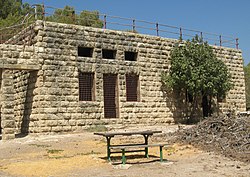Bayt Jiz
| Bayt Jiz | |
|---|---|

The old school of Bayt Jiz
|
|
| Arabic | بيت جيز |
| Name meaning | The ruin of the house of the valley side |
| Also spelled | Beit Jiz |
| Subdistrict | Ramle |
| Coordinates | 31°48′46.26″N 34°57′15.23″E / 31.8128500°N 34.9542306°ECoordinates: 31°48′46.26″N 34°57′15.23″E / 31.8128500°N 34.9542306°E |
| Palestine grid | 145/135 |
| Population | 550 (1945) |
| Area | 8,357 dunams 8.4 km² |
| Date of depopulation | April 20, 1948 |
| Cause(s) of depopulation | Military assault by Yishuv forces |
| Current localities | Har'el,Tzelafon, Gizo |
Bayt Jiz (Arabic: بيت جيز) was a Palestinian Arab village situated on undulating land in the western foothills of the Jerusalem heights, 15 kilometers (9.3 mi) southwest of Ramla. In 1945, it had a population of 550. It was captured by Israeli forces in the 1948 Arab–Israeli War and its inhabitants fled the village.
Nearby Khirbet Bayt Jiz has been claimed as the site of the Biblical Gizo and has been linked to the Crusader settlement of Gith, although the latter association was dubbed as doubtful by some historians.
Since 1136, the village belonged to the canons of the Church of the Holy Sepulchre. By 1171, Gith was one of five villages within the Lydda diocese, in which the canons were permitted by the village bishop to have or build a church and control half the village's tithes.
Bayt Jiz is not recorded in early Arabic sources. According to local legend, the maqam ("sacred Muslim tomb") was built in 1334 to house the sarcophagus of Shaykh Zayd, a local sage. A stone with Arabic inscriptions was found near the maqam, attributing the building of the structure to a Mamluk commander named Sayf ad-Din Aqul. It is the only evidence of early Islamic activity in the village thus far.
In 1838, it was noted as a place "in ruins or deserted."
In 1883, the Palestine Exploration Fund's Survey of Western Palestine described the place, called Khurbet Beit Jiz, as having "traces of ruins and a sacred Mukam. To the south are caves. There are foundations and cisterns among the ruins. On the south-west, in Wady el Kharjeh, are a number of pits containing a perennial supply of good water."
The modern village of Bayt Jiz was founded in the early 20th century.
...
Wikipedia

